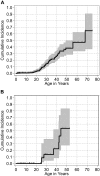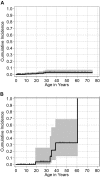Cancer in dyskeratosis congenita
- PMID: 19282459
- PMCID: PMC2710915
- DOI: 10.1182/blood-2008-12-192880
Cancer in dyskeratosis congenita
Abstract
Dyskeratosis congenita (DC) is a rare inherited bone marrow failure syndrome. The spectrum of cancer susceptibility in this disorder of telomere biology has not been described. There were more than 500 cases of DC reported in the literature from 1910 to 2008; the National Cancer Institute (NCI) prospective DC cohort enrolled 50 cases from 2002 to 2007. Sixty cancers were reported in 52 literature cases, while 7 occurred among patients in the NCI DC cohort. The 2 cohorts were comparable in their median overall survival (42 years) and cumulative incidence of cancer (40%-50% by age 50 years). The most frequent solid tumors were head and neck squamous cell carcinomas (40% of patients in either cohort), followed by skin and anorectal cancer. The ratio of observed to expected cancers (O/E ratio) in the NCI cohort was 11-fold compared with the general population (P < .05). Significantly elevated O/E ratios were 1154 for tongue cancer and 195 for acute myeloid leukemia. Survival after bone marrow transplantation for aplastic anemia or leukemia was poor in both cohorts. The frequency and types of cancer in DC are surpassed only by those in Fanconi anemia (FA), indicating that FA and DC have similarly high risks of adverse hematologic and neoplastic events, and patients with these diseases should be counseled and monitored similarly.
Figures




Comment in
-
Cancer & inherited bone marrow failure states.Blood. 2009 Jun 25;113(26):6502-3. doi: 10.1182/blood-2009-04-213116. Blood. 2009. PMID: 19556430 No abstract available.
References
-
- Alter BP. Diagnosis, genetics, and management of inherited bone marrow failure syndromes. Hematology Am Soc Hematol Educ Program. 2007;2007:29–39. - PubMed
-
- Alter BP. Cancer in Fanconi anemia, 1927-2001. Cancer. 2003;97:425–440. - PubMed
-
- Rosenberg PS, Greene MH, Alter BP. Cancer incidence in persons with Fanconi anemia. Blood. 2003;101:822–826. - PubMed
-
- Rosenberg PS, Alter BP, Ebell W. Cancer risks in Fanconi anemia: experience of the German Fanconi Anemia (GEFA) Registry. Haematologica. 2008;93:511–517. - PubMed
Publication types
MeSH terms
Grants and funding
LinkOut - more resources
Full Text Sources
Other Literature Sources
Medical

